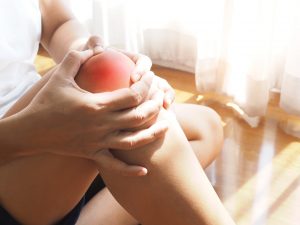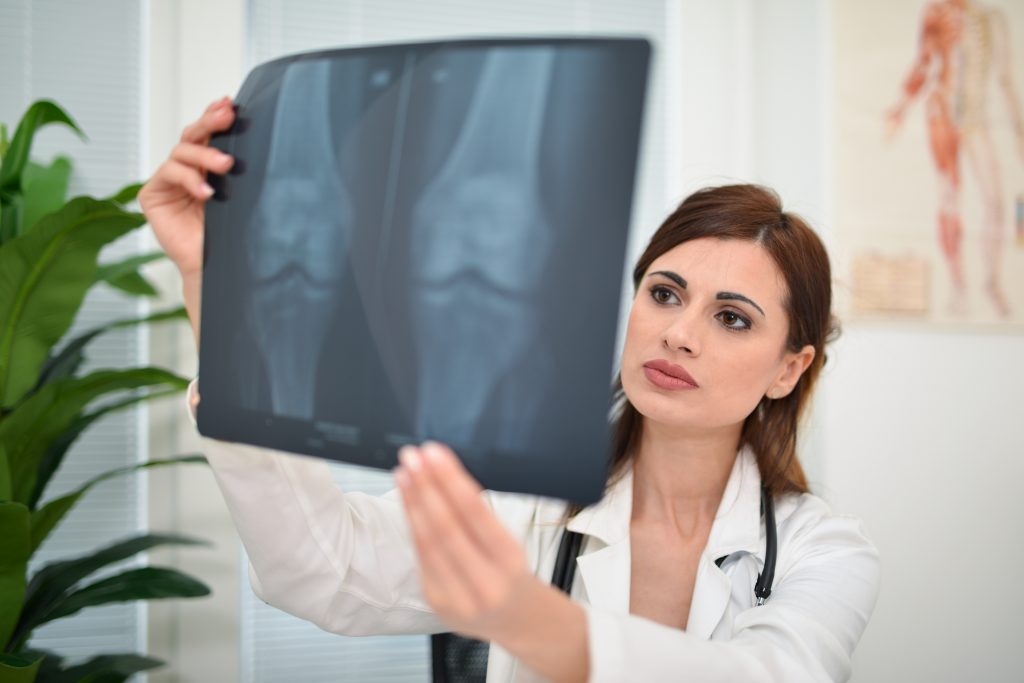Arthritis is a group of rheumatic conditions and diseases that are related by the symptoms of joint pain, stiffness, and swelling. Arthritis is often the underlying cause of knee pain if there has been no injury. It is possible to have more than one type of arthritis at a time and treatment is different depending on the cause.
Arthritis is a disease found mainly in adults; however, there are some forms that may affect children. Although commonly found in the knee, arthritis can develop in any joint in the body. Knee arthritis can cause difficulty when carrying out a number of everyday activities, such as climbing stairs and working in certain fields.
There is no permanent cure for arthritis, but there are various treatments available to help control pain and relieve discomfort.
Causes of Knee Arthritis
Cartilage is a connective tissue found in your joints that protects them by absorbing pressure when you move or put stress on them. Most types of arthritis are linked by a combination of symptoms, but some have no obvious cause. Factors that may increase your risk of developing arthritis include:
Genetics
You may be more likely to develop arthritis if your parents or siblings suffer from the condition.
Age
The risk of developing many types of arthritis increases with age
Gender
Most types of arthritis are more commonly found in women; however, gout (a form of arthritis) develops more frequently in men.
Joint Injury
Damage or injury to a joint can make it more likely to develop arthritis in that particular joint.
Obesity
Excess weight puts stress on joints, particularly your knees, hips and spine. Being overweight may contribute to the development and progression of arthritis in the knee.
Occupation
Any occupation that involves repetitive knee bending and squatting puts you at an increased risk of developing arthritis in the knee.
Types of Arthritis
Osteoarthritis
Osteoarthritis is the most common form of arthritis in the knee. It often develops in people aged 50+, but can occur at any age in life. It is caused by the protective cartilage at the end of your bones gradually wearing away (degenerating) over time. Osteoarthritis can affect any joint, but is most likely to occur in your hands, knees, spine or hips, developing slowly and getting progressively worse.
Post-Traumatic Knee Arthritis
Post-traumatic arthritis is a form of osteoarthritis, often developing after an injury. The injury may heal but post-traumatic arthritis may not surface until years after the injury. Meniscal tears and ligament injuries can cause unsteadiness and added wear on the knee joint, which may lead to arthritis over time.
Rheumatoid Arthritis (RA)
Rheumatoid arthritis is a chronic autoimmune disease, resulting in the immune system attacking its own tissue. This form of arthritis affects joints symmetrically, usually occurring in the same joint on both sides of the body. if RA is left untreated, it can lead to permanent joint damage.
Psoriatic Arthritis
Similar to rheumatoid arthritis, psoriatic arthritis is an autoimmune disease affecting some people who suffer from psoriasis. In general, most people who develop psoriasis can have it for years before being diagnosed with psoriatic arthritis.
Gout
Gout is a common and complex type of arthritis that is characterised by sudden bouts of pain or swelling. Many cases affect the big toe, but it can also occur in the knee and other joints. Gout can lead to a build-up of monosodium urate crystals in the soft tissue of the knee joint, causing swelling and inflammation.
Pseudogout (CPPD)
Like gout, pseudogout is caused by a build-up of calcium pyrophosphate crystals in a joint and can lead to sudden, severe knee pain. Pseudogout is less common than gout but more likely to affect the knee or wrist joint.
Reactive Arthritis
Reactive arthritis often occurs as a reaction to an infection such as a stomach bug or a sexually transmitted disease. It commonly targets your knees, ankles and feet, however the inflammation can also affect your urethra, skin or eyes.
The conditions listed above are common causes of arthritic knee pain. If you suffer from chronic knee pain, make an appointment with your doctor to get an accurate diagnosis.
Symptoms of Knee Arthritis
The most common signs and symptoms of arthritis involve the joints. Your symptoms will vary depending on the type of arthritis you have but may include:
Pain
Arthritic pain can come on suddenly, although it is more likely to develop slowly over a period of time. You may notice it is worse in the morning or after being inactive for a while. Climbing stairs, kneeling or walking can also cause pain in your knees. Many people who suffer with arthritis notice that damp, rainy weather can increase the pain.
Inflammation
Joint inflammation is generally caused by an overactive immune system. Swelling may be more obvious after a long period of inactivity, such as when you wake up in the morning. The skin around the affected joint may look red and feel warm to touch.
Weakness
Your knee muscles may weaken over time and cause the entire joint to become unstable. Weakness in the knee can cause it to give way or buckle. The joint can also lock so that you struggle to bend or straighten it.
Motion
Loose fragments of cartilage can cause a limited range of motion in the affected joint, sometimes causing it to lock or stick during movement and possibly create a grinding sensation as your knees move. If you suffer from arthritis in your knee and hear a grinding noise, this is a result of rough surfaces and bone spurs rubbing against each other.
Bone Spurs (Osteophyte)
A bone spur is a small pointed, outgrowth of bone developing along the bone edges, forming where bone meets other bone in your joints, reflecting the body’s attempt to repair itself. A common symptom of osteoarthritis, bone spurs usually develop due to inflammation (degenerative arthritis) or injury.
Deformity
As arthritis progresses, the muscles around your knee start to thin and weaken, changing the appearance and making the knee look sunken or misshapen. Over time, your knees can start to point toward each other or outwards (knock-knees or bow-legs).
Diagnosing Knee Arthritis
A successful diagnosis of arthritis is the first step toward effective treatment. Your doctor will perform a physical exam to check your joints for swelling, warmth and redness. Depending on the type of arthritis the doctor suspects, they may suggest the following tests:
Laboratory Tests
Laboratory tests are a medical technique that performs an analysis of different types of body fluids to help identify the type of arthritis you may have. Fluids typically analysed include bloody, joint fluid and urine.
Imaging Tests
Imaging tests can reveal problems within your joint that may be causing your symptoms.
X-rays
An X-ray is a painless procedure designed to help your doctor look inside your body to diagnose a condition. It is a particularly effective technique of viewing your bones and helpful in diagnosing a wide range of conditions. X-rays may not detect early signs of arthritis, but they can track progression of the disease.
Magnetic Resonance Imaging (MRI)
An MRI scan is a safe and painless diagnostic tool that produces a detailed picture of the tissue and organs inside of your body, using strong magnetic fields and radio waves.
Ultrasound
This technology uses high-frequency sound waves to create an image of the cartilage, soft tissues and fluid-filled structures near the joints. Ultrasound can be used to guide needle placement for joint aspirations and injections. Ultrasound scans are safe because they use sound waves or echoes to create an image, instead of radiation.
Lifestyle Changes/Home Remedies
Healthy Lifestyle
Pain may have caused you to limit what activities you participate in, but it is important to maintain a healthy, active lifestyle. Carrying excess weight can add stress to the joints which can increase pain. Exercise helps maintain joint function, bone and muscle strength. It has been proven that Omega-3 fatty acids can help reduce inflammation and regulate the immune system.
Hot and Cold Therapy
Hot and cold treatments are effective techniques for reducing arthritic pain. Heat therapy can improve circulation and soothe stiff joints and sore muscles. Cold therapy restricts blood vessels, which causes circulation to slow, reducing swelling, and numbing pain.
Medication
Some examples of medications that may be suggested include:
- Analgesics are medicines used for pain control
- NSAIDs (Non-steroidal anti-inflammatory drugs), such as aspirin and ibuprofen to relieve pain and reduce fever
- Corticosteroids injections are used to decrease inflammation
- Disease-modifying anti-rheumatic drugs (DMARDs) work by altering the disease, slowing or stopping inflammation and reducing pain.
Massage
Regularly massaging the muscles and joints may reduce symptoms of pain, ease inflammation and improve mobility for people with knee arthritis by increasing circulation.
Treatment Options
Your doctor may suggest surgery as a last resort if the symptoms are not relieved with non-surgical treatment, persistent pain, limited mobility or a general deterioration in your quality of life. Knee surgery to relieve arthritis pain is considered elective surgery (it is up to the patient to decide).
Surgical Options for Knee Arthritis
Joint Repair
In certain cases, joint surfaces can be smoothed or readjusted to decrease pain and recover function. This type of procedure is often carried out using keyhole surgery (knee arthroscopy) by making small incisions over the joint and inserting a thin flexible tube with a camera and light on one end. type of surgery is less invasive compared to open surgery and usually results in a quicker recovery period.
Joint Replacement
Knee replacement surgery is a surgical procedure, whereby the damaged knee joint is replaced with an artificial material (a prosthesis). Read more on knee replacement surgery here
Joint Fusion
Joint fusion surgery works by fusing together the two bones that make up the aching joint creating one, solid bone.





 One Ashford
One Ashford One Hatfield
One Hatfield